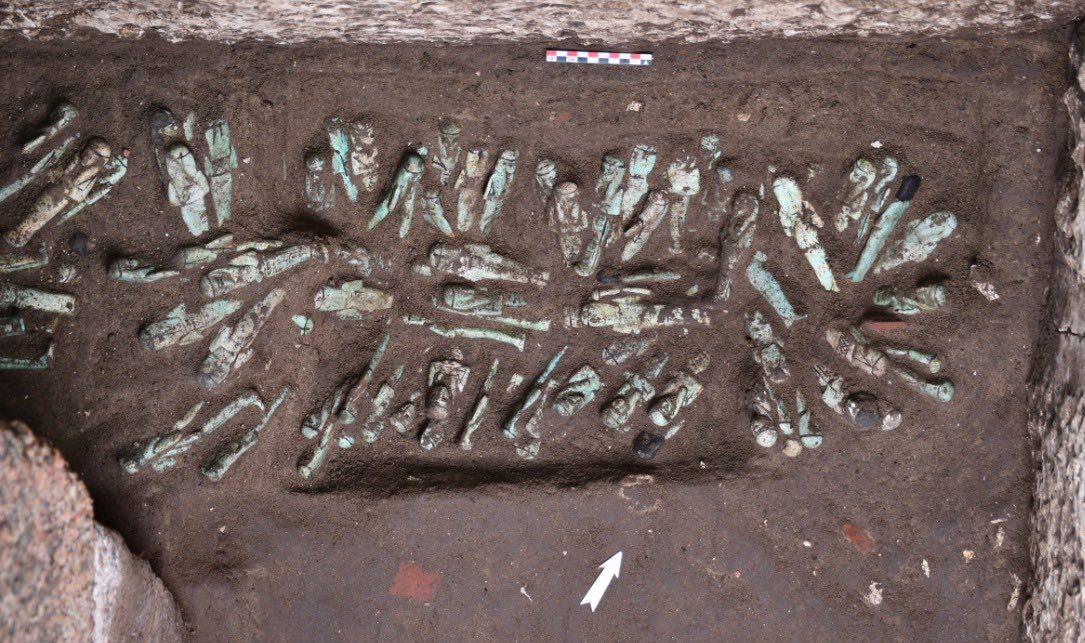Ancient Egyptian pharaoh moved another ruler's body and stole his tomb, hundreds of funerary figurines suggest
Archaeologists have discovered 225 shabtis — figurines meant to work for the deceased in the afterlife — in a pharaoh's tomb.

Archaeologists in Egypt have discovered 225 shabtis — figurines meant to act as servants for the deceased in the afterlife — that belonged to the pharaoh Shoshenq III inside a tomb of a different pharaoh.
The figurines were found at the site of Tanis, in northern Egypt, in the northern chamber of the tomb of Osorkon II, near an unmarked sarcophagus. Hieroglyphs on the shabtis allowed the team to identify who they belonged to.
Although the tomb and sarcophagus were discovered in 1939, the shabtis were recently found by an Egyptian-French team that is conducting conservation work, the Egyptian Ministry of Tourism and Antiquities said in a translated statement. The team also uncovered new inscriptions that they are in the process of deciphering and analyzing.
Ancient Egyptians believed that shabti (also known as ushabti) figurines would work for the deceased in the afterlife, performing a wide variety of tasks such as farmwork and bringing the deceased objects, and they are often found in Egyptian tombs. The wealthy and powerful tended to be buried with hundreds of shabtis; for instance, the tomb of Tutankhamun has more than 400 of them.
Shoshenq III (also spelled Sheshonq III) reigned from around 825 to 773 B.C., when Egypt was not unified. Shoshenq III's "reign was long but difficult, with a bloody dynastic war between kings of the North [himself] and two kings in the south [his cousins] of Egypt," Frédéric Payraudeau, director of the French archaeological mission at Tanis, whose team found the shabtis, told Live Science in an email.
Despite the conflict, Shoshenq III managed to build "many monuments in Tanis [especially] a great Gate in the entry of the main temple precinct," Payraudeau said. The pharaoh also built a tomb for himself at Tanis, where Osorkon II (who ruled from about 874 to 850 B.C.) had already been buried. Both Osorkon II and Shoshenq III are part of what modern-day Egyptologists call the 22nd dynasty of Egypt.

The discovery of the shabtis, which are made of faience (glazed ceramic), inside Osorkon II's tomb indicates that Shoshenq III was not buried in his tomb but rather in an unmarked sarcophagus in the tomb of Osorkon II. Researchers have long known about this tomb, but they didn't know that Shoshenq III was buried there.
Get the world’s most fascinating discoveries delivered straight to your inbox.
"The presence of the shabtis near the anonymous sarcophagus and also inscriptions on the connected wall indicates clearly that [Shoshenq III] was buried here and not in his own tomb," Payraudeau said.
Why Shoshenq III was buried in a predecessor's tomb "is a question we have to think about," he said, noting that it could be due to the conflict or arguments over Shoshenq III's succession.
Some of the artifacts in Shoshenq III's tomb carry the name of Shoshenq IV, who ruled during the following 23rd dynasty, said Aidan Dodson, an Egyptology professor at the University of Bristol in the U.K who was not involved with the research. "So the latter may have taken over the tomb of Shoshenq III and buried Shoshenq III in the nearby tomb of Osorkon II," Dodson told Live Science in an email.
In ancient Egypt, it wasn't unusual for tombs to be reused. However, why Shoshenq IV might have reused the tomb of Shoshenq III and moved him to the tomb of Osorkon II is unclear.
Conservation of Osorkon II's tomb and analyses of the shabtis and inscriptions are ongoing.
Mummy quiz: Can you unwrap these ancient Egyptian mysteries?

Owen Jarus is a regular contributor to Live Science who writes about archaeology and humans' past. He has also written for The Independent (UK), The Canadian Press (CP) and The Associated Press (AP), among others. Owen has a bachelor of arts degree from the University of Toronto and a journalism degree from Ryerson University.
You must confirm your public display name before commenting
Please logout and then login again, you will then be prompted to enter your display name.
